Intel Rocket Lake (14nm) Review: Core i9-11900K, Core i7-11700K, and Core i5-11600K
by Dr. Ian Cutress on March 30, 2021 10:03 AM EST- Posted in
- CPUs
- Intel
- LGA1200
- 11th Gen
- Rocket Lake
- Z590
- B560
- Core i9-11900K
Gaming Tests: Final Fantasy XV
Upon arriving to PC, Final Fantasy XV: Windows Edition was given a graphical overhaul as it was ported over from console. As a fantasy RPG with a long history, the fruits of Square-Enix’s successful partnership with NVIDIA are on display. The game uses the internal Luminous Engine, and as with other Final Fantasy games, pushes the imagination of what we can do with the hardware underneath us. To that end, FFXV was one of the first games to promote the use of ‘video game landscape photography’, due in part to the extensive detail even at long range but also with the integration of NVIDIA’s Ansel software, that allowed for super-resolution imagery and post-processing effects to be applied.
In preparation for the launch of the game, Square Enix opted to release a standalone benchmark. Using the Final Fantasy XV standalone benchmark gives us a lengthy standardized sequence to record, although it should be noted that its heavy use of NVIDIA technology means that the Maximum setting has problems - it renders items off screen. To get around this, we use the standard preset which does not have these issues. We use the following settings:
- 720p Standard, 1080p Standard, 4K Standard, 8K Standard
For automation, the title accepts command line inputs for both resolution and settings, and then auto-quits when finished. As with the other benchmarks, we do as many runs until 10 minutes per resolution/setting combination has passed, and then take averages. Realistically, because of the length of this test, this equates to two runs per setting.
| AnandTech | Low Resolution Low Quality |
Medium Resolution Low Quality |
High Resolution Low Quality |
Medium Resolution Max Quality |
| Average FPS | 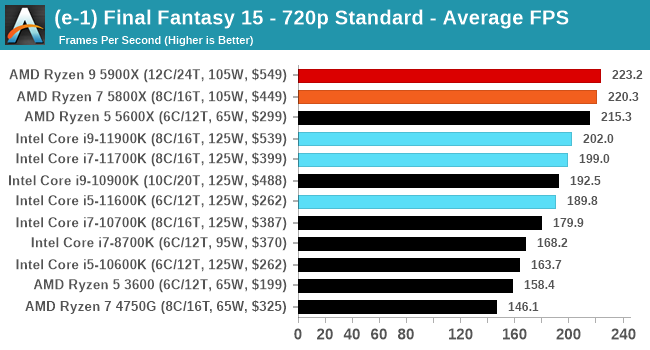 |
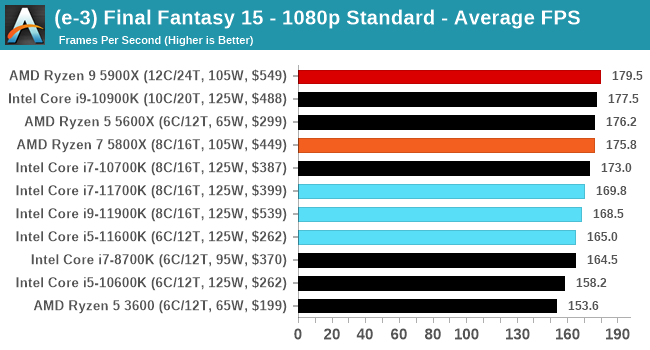 |
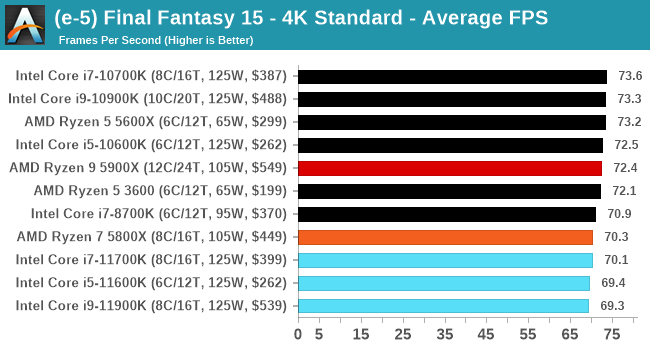 |
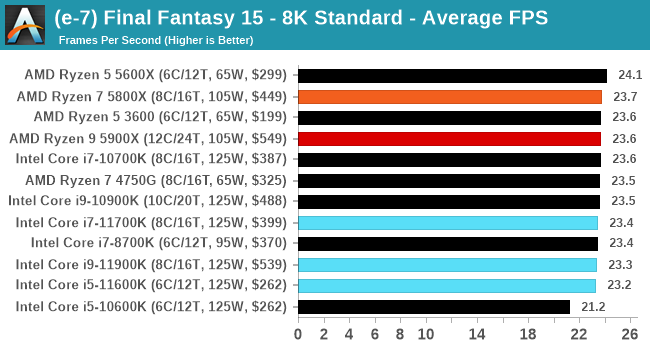 |
| 95th Percentile | 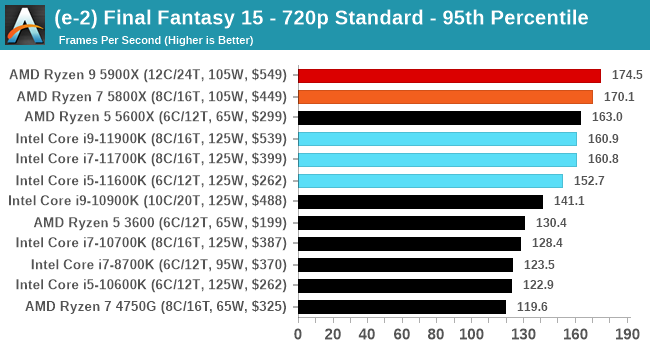 |
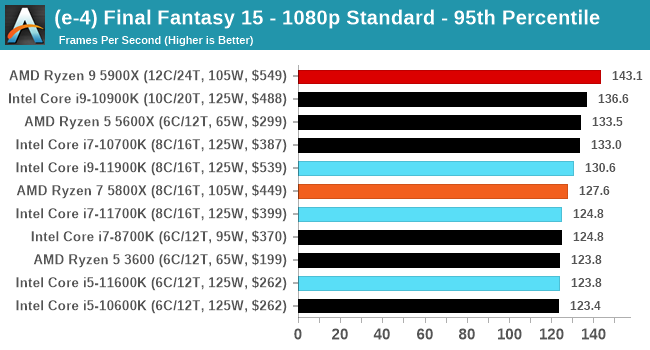 |
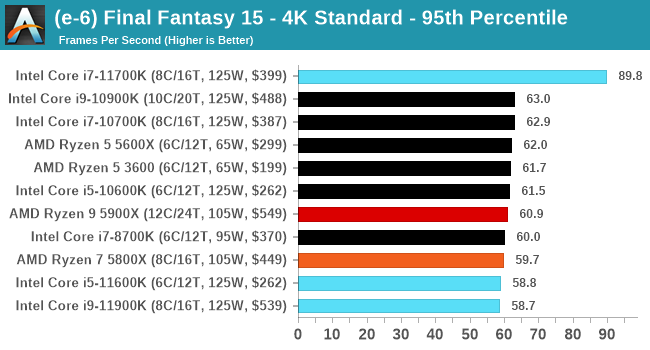 |
 |
All of our benchmark results can also be found in our benchmark engine, Bench.












279 Comments
View All Comments
SystemsBuilder - Wednesday, March 31, 2021 - link
and you are a Computer Science graduate? What Linus T. is saying is that AVX-512 is a power hog and he is right about that. Linus T. is not saying that "a couple dozen or so people" are able to program it. Power requirements and programing hardness are 2 different things.On the second point, I 100% stand by that any decent Computer Science/Engineering graduate should be able to program AVX-512 effectively (overcoming hardness not power requirements).
Also, I do program AVX-512 and I 100% stand by what I said. You just need to know what you are doing and vectorize algorithms. If you use the good old sequential algorithms you will not archive anything with AVX-512, but it you vectorize you're classical algorithms you will also achieve >100% benefits in many inner loops in so called mainstream programming. AVX-512 can give you 2x uplift if you know how to utilize both FMA units on port 0+1 and 5 and it's not hard.
Lastly, with decent negative AVX-512 offsets in BIOS, you can bring down the power utilization to ok levels AND still get 2x improvements in the inner loops (because of vectorized algorithmic improvement).
Hifihedgehog - Wednesday, March 31, 2021 - link
> and you are a Computer Science graduate?No, I am a Computer Engineering graduate. Sorry, but you are grasping at straws. Plus you are overcomplicating the obvious to try to be an Intel apologist. Just see this and this. Read it and weep. Intel flopped big time this release:
https://i.imgur.com/HZVC03T.png
https://i.imgflip.com/53vqce.jpg
SystemsBuilder - Wednesday, March 31, 2021 - link
So fellow CS/CE grad. I'm not arguing that AVX-512 is a power hog (it is) or that the AVX-512 offsets slows down the rest of the CPU (they do). I am arguing the premise that AVX-512 is supposed to be so incredibly hard to do that only "couple dozen or so people" can do is wrong today - Skylake-X with AVX-512 was launched 2017 for heaven's sake. Surely, I can't be the only CS/CE guy how figured it out by now. I mean really? When Ian wrote what Keller said (and keep on writing it) that that this AVX-512 is sooo hard to do that only a few guys on the planet can do it well, my reaction was "let's see about that". I mean come on guys, really!SystemsBuilder - Wednesday, March 31, 2021 - link
More specifically Linus is concerned that because you need to use negative offsets to keep the power utilization down when engaging AVX-512 it slows down everything else going on. i.e. AVX-512 power requirements overall CPU impact. The new cores designs (already Cypress Cove maybe? but Sapphire Rapids definitely!) will allow AVX-512 workloads to run at one frequency (with lower negative offsets that for instance Skylake-X) and non AVX-512 workloads at a different frequency on various cores and keep within the power budget. this is ideal.arashi - Wednesday, March 31, 2021 - link
This belongs in r/ConfidentlyIncorrect and r/IAmVerySmart, anyone who thinks coding for AVX512 PROPERLY is doable by "any CS/CE major graduate worth their salt" would be laughed out of the industry.Hifihedgehog - Wednesday, March 31, 2021 - link
Exactly. The real reason for the nonsensical wall of text is SystemsBuilder is trying desperately to overexplain things to put lipstick on a pig. And he repeats himself too like I am listening to an automated bot caught in a recursive loop which is quite funny actually.SystemsBuilder - Wednesday, March 31, 2021 - link
So you are a CE major, have you actually tried to program in AVX 512? If not, try to do a matrix by matrix multiplication of 16x16 FP32 matrices for instance and come back. You'll notice incredible performed increase. It's not lipstick on a pig, it actually is very powerful, especially computing through large volumes of related data SIMD style.Meteor2 - Saturday, April 17, 2021 - link
Disappointing response. You throw insults but not rebuttals.Me thinks SB has a point.
SystemsBuilder - Wednesday, March 31, 2021 - link
really? any you are one CS graduate? have you tried?MS - Tuesday, March 30, 2021 - link
What the he'll is that supposed to mean that you can't you can't get the frequency at 10 nm and therefore you have to stick with the 14 nm node? That's pure nonsense, AND is at 7 nm and they are getting the target frequencies. Maybe stop spreading the Coolaid and call a spade a spade....